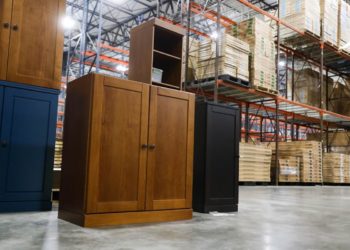Robots are becoming more and more like humans. They can build cars, clean your house and even do parkour. But can they make an edible and enjoyable meal? To find out, I cooked against three levels of robots to determine who the better chef is. My findings along the way were surprising, with an outcome that no one expected.
Level one: basic skills vs. simple gadgets
In the first level, I used the most basic kitchen robots money can buy. I went head-to-head with different tools that you may have seen on social media or in a grocery store. I put them to the test in five different speed rounds. To win, it’s best three out of five.
First challenge: chopping food vs. Robot Coupe
The Robot Coupe is an advanced food processor that effortlessly dices potatoes into perfect cubes. All it needs is one person to put the potatoes into the slicer — no other human work is required. In under 10 seconds, the machine perfectly chopped three potatoes into small, precise cubes that would take a chef a lot of skill and time to cut.
Up against the clock, I struggled with uneven cuts. The robot’s consistent and flawless performance highlights one of its key strengths: efficiency. Robots can perform repetitive tasks faster and more accurately than humans, a quality especially beneficial in a fast-paced kitchen. If I had more time, I could have chopped the potatoes similarly to the Robot Coupe, but under the time constraints, it was no contest.
Winner: chopping robot
Second challenge: hand stirring vs. automatic stirrers
The second challenge presented five pans of pine nuts in front of each team. The test: to toast the pine nuts perfectly without burning them or neglecting the pan. I had to stir five pans of pine nuts at once, while the robot team used an automatic stirrer in each pan. Pine nuts are expensive and burn easily, so it’s important not to mess up the process.
As my pine nuts started toasting, I felt rushed to stir each pan one after the other. I could tell they were close to burning if I took too long on one pan over another. I also switched the pans to different burners halfway through to even out the heat exposure. After the speed round was over, I checked the pine nuts and somehow, I managed to toast them all to a perfect, even golden brown.
The robots, however, surprised me. The device only had one stirring pattern — a circular motion, placed in the middle of the pan. This pushed all the pine nuts to the outer edges of the pan, to the point where the stirrer couldn’t even reach them anymore. All of the pine nuts burned, and the stirrers even melted onto the bottom of the pan.
Winner: me (in a landslide)
Third challenge: traditional toasting vs. a fancy robot toaster
Up next was a challenge to toast bread, which is a simple form of cooking that I’d bet most adults have done in their lifetime. I used a pan with butter, while the robot team used a $500 toaster with a touch screen. The toaster offers a variety of settings for each type of bread — all you have to do is click on the picture of what you are toasting, and the rest is up to the robot.
The robot toasted the bread faster than I did, although not by much. Mine was already buttered during the cooking process, while the robot’s toast had to be buttered by a human. The time to prepare both toasts, however, equaled out to each other when the robot operator had to take time to butter them.
Upon taste testing, it was clear that the human-made version was better. I was able to keep an eye on the bread and toast it evenly, while the robot toasted patchy, burnt parts onto the bread. Sometimes, a human eye is more diligent than AI.
Winner: me
Fourth challenge: handmade pizza vs. an automatic pizza maker
In speed round number four, we stepped it up a bit. I made a pizza by hand, while a robot prepared an entire pizza. The only caveat with the robot is that you still have to make the sauce and dough, and you also have to cook it. Therefore, the machine requires a lot of human effort. It only applies the toppings to the dough.
After both pizzas were prepped for the oven, it was clear that the robot’s pizza was more visually appealing. The toppings were evenly spread, thanks to the robot’s AI scanner, and ultimately created a far more balanced bite than mine.
Winner: pizza robot
Fifth challenge: cleaning with a mop vs. a Roomba
The final speed round involved something many of us use at home to save time: the Roomba. I went up against the Roomba to see who could clean up a mess faster and more efficiently. We spread flour on the floor and divided the mess in half for each team.
One thing about the Roomba — it couldn’t see the mess. It only knows how to go around the entire room, so it kept circling around the mess and cleaning other parts of the room instead. Eventually, the mess would have been cleaned up, but who knows how long that would have taken? The Roomba also began leaking flour as it moved around, making a bigger mess than it started with.
I used a traditional mop to clean the floor. Although it involved more labor, it was quick and easy to get rid of the mess. In that short amount of time, I may have missed a few spots, but the floor was a million times cleaner than the robot’s side.
Winner: me
I won the first level fair and square, but it was time to kick things up a notch and see where a human’s faults lie in the AI world.
Level two: cooking against Moley — the world’s first fully robotic kitchen
In the second level, I cooked against Moley, the world’s first fully robotic kitchen, with a price tag of $100,000. It can recreate the movements of a professional chef and has more than 5,000 recipes uploaded to its memory. We went head-to-head to see who could create a better pasta dish, with a blind taste test determining the winner.
I chose for Moley to make a spaghetti puttanesca. Humans must prepare the ingredients, like chopping garlic and onions, but Moley does the rest. It even puts the ingredients in the pan itself.
While cooking, I noticed that Moley didn’t fully submerge the pasta in the boiling water or mix the sauce in evenly once the pasta was cooked. I also plated Moley’s dish in a more appealing way so the judge wouldn’t be able to tell which was which, as we were focusing on flavor rather than appearance. Aside from those outliers, Moley did everything else as well as I could.
When it was time for me to cook, I opted to make uni butter pasta. I didn’t use measured portions like Moley and just eyeballed everything. I plated it with a few pieces of fresh uni and microgreens, making it visually appealing.
Our blind taste tester surprisingly guessed that the robot made the uni butter pasta. They claimed that the puttanesca had a better taste, was more complex and that only a human could cook it. I lost to the robot fair and square at this level, and it was time to reclaim my throne.
Winner: Moley
Level three: preparing a steak dinner against a human-like robot
For this final round, I cooked a steak against Neo Beta, an advanced humanoid robot. This robot is built to look and act like a human. We had three steaks to choose from: a porterhouse, filet mignon and a ribeye. Both of us would cook one, and I’m leaving it up to our readers to decide who won this round.
Neo Beta chose the filet, and I picked the ribeye. Not only did Neo Beta cook the steak from start to finish with no human intervention, but it also held a conversation with me while cooking. The one thing Neo Beta needed help with was cutting potatoes, as using knives isn’t a feature it is equipped with yet.
I cut open the steaks and was shocked to find that we had both cooked them to a perfect temperature. I thought for sure the robot would either overcook or undercook the steak, but it looks like AI can do some things just as well as humans — possibly even better.
In my opinion, both steaks look incredible. I would have never guessed that a robot could cook such a nice looking meal. It might be hard to choose a winner. What do you think?
A reflection on the use of AI in the kitchen
At the end of the competition, it’s clear that robots and humans both have strengths. Robots are helpful for tasks that require precision, speed and consistency. But when it comes to the mastery of cooking, the ability to innovate, improvise and be inspired by emotion, humans still come out on top.
The future of cooking just might involve robots and humans working side-by-side. Robots could handle the repetitive tasks, while humans will continue to bring the creativity, passion and intuition that make food an experience. The challenge, then, isn’t about who is better — humans or robots — but rather how they can complement each other in a way that enhances efficiency and creativity.
Let me know who you think won the last challenge by commenting on my video below!
The post Can robots outcook a professional chef? I put them to the test appeared first on .




